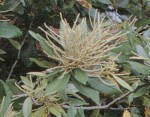 Tan oak is an evergreen shrub or tree native to western US from Oregon to California where it grows on dry, rocky slopes and in chaparral. It is a member of the beech family, Fagaceae, that also includes chestnuts. The thick, leathery leaves are three to six long and are shiny light green with whitish undersides. They are coarsely toothed and covered with orange-brown hairs when young. Upright catkins two to four inches long of small male flowers that are white before tuning rust colored appear from late spring to early summer. Inconspicuous yellow-green female flowers are produced at the base of the catkins and give way to small clusters of one inch long egg-shaped acorns that require eighteen months to mature. Each acorn has a saucer-shaped cup with dense spines and a woody nut shell. Although eaten by squirrels, the nuts are very bitter and Native Americans leached them before grinding them into flour. Useful as a specimen, hedge, screen, or in borders and woodland gardens. The genus name Notholithocarpus comes from the Latin word nothus meaning false, and the Greek words lithos meaning stone, and karpos meaning fruit, referring to the acorn. The specific epithet, densiflorus comes from the Latin words densus meaning dense or crowded, and florus meaning flowered.
Tan oak is an evergreen shrub or tree native to western US from Oregon to California where it grows on dry, rocky slopes and in chaparral. It is a member of the beech family, Fagaceae, that also includes chestnuts. The thick, leathery leaves are three to six long and are shiny light green with whitish undersides. They are coarsely toothed and covered with orange-brown hairs when young. Upright catkins two to four inches long of small male flowers that are white before tuning rust colored appear from late spring to early summer. Inconspicuous yellow-green female flowers are produced at the base of the catkins and give way to small clusters of one inch long egg-shaped acorns that require eighteen months to mature. Each acorn has a saucer-shaped cup with dense spines and a woody nut shell. Although eaten by squirrels, the nuts are very bitter and Native Americans leached them before grinding them into flour. Useful as a specimen, hedge, screen, or in borders and woodland gardens. The genus name Notholithocarpus comes from the Latin word nothus meaning false, and the Greek words lithos meaning stone, and karpos meaning fruit, referring to the acorn. The specific epithet, densiflorus comes from the Latin words densus meaning dense or crowded, and florus meaning flowered.

Type: Evergreen tree or shrub
Outstanding Feature: Foliage
Form: Conical to rounded
Growth Rate: Slow
Bloom: Upright catkins two to four inches long of small male flowers, white before tuning rust colored, from late spring to early summer; inconspicuous yellow-green female flowers produced at the base of the catkins
Size: 10-130’ H x 20-30’ W
Light: Full sun, partial shade
Soil: Fertile, moist, well-drained; somewhat drought tolerant once established.
Hardiness: Zones 7-10
Care: Low maintenance
Pests and Diseases: Very susceptible to by “sudden oak death” (Phytophthora ramorum),
Propagation: Seed (acorn)
Acorn photo from Wikimedia Commons, USDA